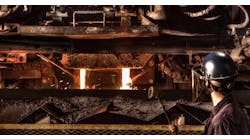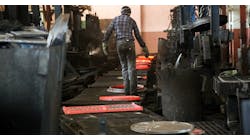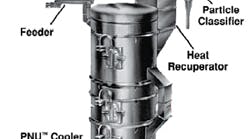Mixing and handling sand are among the most carefully managed processes in many foundries, and the task of “reclaiming” sand is gaining an increasingly important role. With its positive impact on both operating costs and environmental control, reclaiming sand is among an emerging class of “clean plant” technologies.
GMD Environmental Technologies is a singlesource supplier of a wide range of clean-plant technologies — air pollution control, acid gas treatment, hazardous dust conditioning, and off-gas cooling plus solid waste recycling. GMD has been designing, engineering, and manufacturing environmental equipment for 30 years, and was absorbed by CECO Environmental Corp. in 2007.
Included in its list of designs are sand-reclamation systems, particularly for foundries. GMD’s PNU cooler and cooler-scrubber are the main components in two thermal reclamation systems, one for chemically bonded sand reclamation, and one for clay-bonded sand reclamation.
The PNU cooler is a conventional fluid-bed design for fluidizing air distribution by providing direct cooling with the air, and indirect cooling through finned water coils in the fluidized bed. The finned waster cooling tube banks and baffle plates direct the sand across the tube banks, and because the sand is denser than water, it acts as a fluid. These actions create rapid, intimate mixing that produces rapid heat transfer from the sand to the fluidizing air, which carries the heat as exhaust air.
In addition to this direct cooling, the finned water-cooling tube banks provide indirect cooling at a higher total efficiency. The water is externally cooled by a conventional evaporative cooling tower after being pumped through the coils.
Above the bed of sand is a freeboard space, kept at a slight negative pressure due to the dust collector connection. This draws off the fluidizing air in addition to classification as unwanted sand fines are removed via the exhaust system.
The PNU cooler has options, like a package of PLC and graphics controls that allow operators to let the systems perform unattended. GMD also offers a surge bin and feed system.
The PNU cooler-scrubber takes the process a step further. After a cooling process that’s similar to the PNU cooler, the PNU cooler-scrubber moves the sand into the scrubber section where the sand grains are withdrawn from the fluidized bed, forced up the blast tube, and impacted against layers of sand grains being held against a target by the blast air. Giving up its energy, the sand falls back to the fluid bed, where it is collected and withdrawn again, and directed up the blast tube. This process is repeated, causing the binders, clay, and metallic oxides to dislodge from the sand grains.
Any material removed from the sand grains during the process, along with unwanted silica fines, is drawn off in a controlled atmosphere and expelled to the dust-collection equipment.
Recirculation of the sand continues until the sand passes over the final weir, discharging from the PNU scrubber, ready for reuse by the foundry. This system also has PLC controls and a graphics controls package for unattended operation, as well as the surge bin and feed system. There is also an absence of moving parts, as in the PNU cooler. The PNU cooler-scrubber also features high scrubbing efficiency, continuous processing, and the integration of cooling and scrubbing.
PNU Cooler-Scrubber
GMD’s chemically-bonded thermal sand reclamation system consists of a surge bin, PNU cooler, particle classifier, heat recuperator, and the Thermo-Scrubber 2000 resin-bonded sand reclaimer. This design effectively processes chemically bonded foundry sands for reuse in the coreroom, or as new sand additions in the molding sand.
The Thermo-Scrubber 2000 is designed for foundries that want to reclaim only resin-bonded sands for reuse. Close-coupled fluid beds provide calcining and precooling on a continuous basis by means of hot air scrubbing and gravity transfer, also without moving parts. It provides singlepass processing and finite temperature control. Efficiency is maximized through continuous processing, hot process yield, and high thermal efficiency.
The GMD clay-bonded thermal sand reclamation system is designed to operate much like the chemically-bonded thermal sand reclamation system, except that the PNU cooler-scrubber replaces the PNU cooler, and the Thermo-Scrubber 2000 is replaced by the Thermo-Scrubber TS claybonded sand reclaimer.
The Thermo-Scrubber TS clay-bonded works in much the same way, reclaiming clay-bonded sand in addition to resinbonded sands for reuse in the coreroom, or as new sand additions in molding sand.









